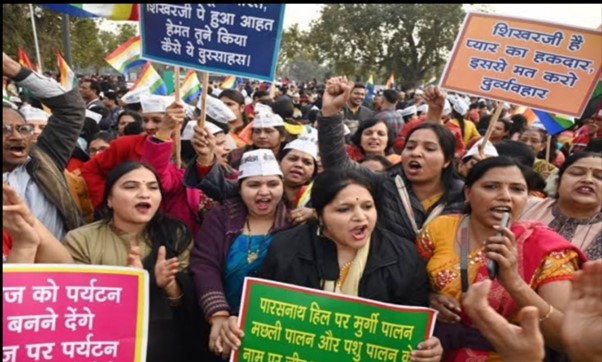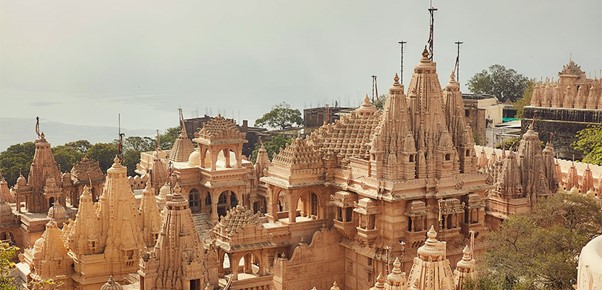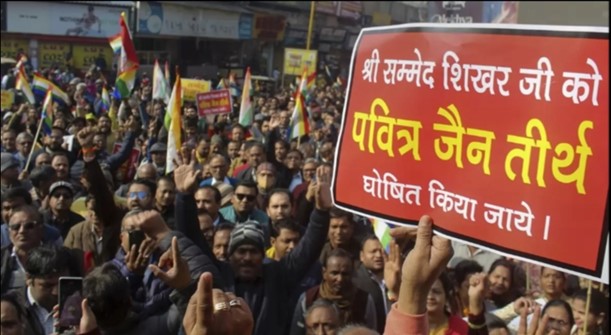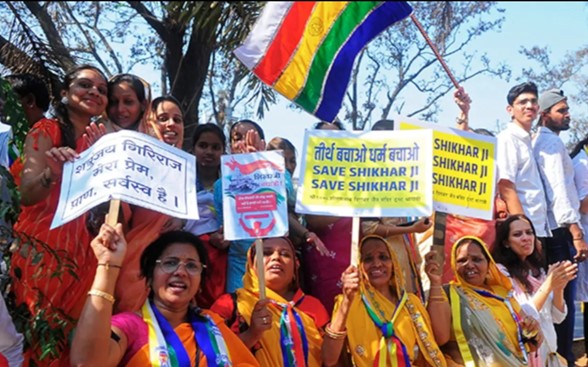Over the past three days, there has been an unheard-of outpouring of Jain community members on the streets of Ahmedabad, Surat, Mumbai, Bhopal, and Delhi, to name a few places. There are two divergent points of view. First, the Jharkhand government decided to develop Sammed Shikharji, a hill temple that is revered both spiritually and religiously by the Jain community, as an ecotourism attraction. Second, there has been vandalism, suspected encroachment, and the sale of illicit alcohol close to Shatrunjaya hill in Palitana town in Bhavnagar, Gujarat.
Only five million individuals worldwide belong to the tiny minority group that holds these locations in high respect from a religious standpoint. This community is primarily concentrated in India’s Gujarat, Rajasthan, and Mumbai. Although not a significant electoral force, Jains are nonetheless seen to have considerable influence in western regions. For instance, some of the more well-known Jain families that are influential in their respective areas include the Adani family, Lalbhai family of the Arvind group, Dilip Shanghvi of Sun Pharma, former Gujarat chief minister Vijay Rupani, and owners of the Times group.
Attempts were made in Gujarat during the early years of the BJP government to include Jains as Hindus on paper, but the community resisted and has since maintained its “minority community status” as an independent religion despite having many similarities to Hindu communities’ religious practices and way of life. Despite having a tenuous caste affiliation with Baniyas in the Hindu caste system, they formally preserve their religious freedom. When surnames overlap, they are referred to as Jain vaniyas. The most prevalent Shah is used by both Jains and Hindus.

Although this is the upper echelon of the community, the majority of Jains in urban areas are middle and upper-class businesspeople, traders, and entrepreneurs. Given the influence, it surprised everyone, especially the community members, to see such a large outpouring. It’s interesting to note that a number of spiritual leaders from different sub-communities, rather than a single community leader, are behind these protests.
Approximately 200 Jain Sanghs, 1,000 saints, 125 Jain youth mandals, and 80 women’s mandals, supported by over 100 Hindu community groups, over 50 MLAs, and thousands of students and devotees, had participated in the rallies on January 1 in Ahmedabad alone, according to a statement released by Samagra Jain Shwetambar Murtipujak Tapagach Sri Mahasangha. Various reports claim that 50,000 people protested in Mumbai’s streets and that more than 100,000 people assembled in Borivali at another location.
Problems: Palitana Tirth-
There are 865 small and large Jain temples in Palitana town. Each year, 50,000 or so people go to these temples. In the Giridih district of Jharkhand, Sammed Shikharji is visited by twice as many people. There, 20 of the 24 Tirthankars are said to have attained spiritual salvation, according to Jain scriptures.
Gujarat has been seeing protests for a while now following the desecration of a Lord Adishwar idol in Palitana in November 2022. Community leaders have previously called attention to illegal mining and the sale of illicit alcohol in the area. When no arrests were made in the matter at the time, but tensions were closely controlled until the assembly elections were done, resentment was already seething. Only with the swearing-in of the new government last month did the first indications of displeasure surface.

Powerful community leaders approached the government shortly after, and Ahmedabad saw the beginning of smaller-scale protests. On December 23, the idol desecration lawsuit was resolved. Police detained a small-time robber named Pintu Gohil, who was upset that he had broken in but had not discovered anything of great worth. Union home minister Amit Shah paid a symbolic visit to the Mahudi Jain temple in Gandhinagar on December 24 as the discontent was growing.
On January 1, protesters showed up despite the arrests, and the Bhavnagar police responded by setting up 24-hour security outside the Palitana temples. There are four major concerns with Palitana. One is the idol’s degradation, which has already been addressed. The next stop is an old Shiva temple where local believers desire to spend Mahashivratri and the night. While day visitation is unrestricted, the Jain religion forbids overnight stays. The other issues are illegal mining and land grabbing by locals, as well as local elements’ extortion of doliwalas (people who pull people up hills in palanquins because they are unable to climb the more than 3,500 steps), according to Vikram Jain, a prominent protester and BJP spokesperson in Ahmedabad.

Sammedh Shikharji Tirth-
The Jains’ dismay at the Jharkhand government’s plan to develop Sammed Shikharji as an ecotourism destination stoked the already-simmering protests in Gujarat. The locals urged that the town be designated as a holy pilgrimage town instead, claiming that doing so would undermine the sanctity of the location. The initiative in Jharkhand was first proposed three years ago, when the BJP was in power, according to Yogesh Shah, a spokesperson for the Samagra Jain Samaj, Ahmedabad. As more and more people visit for worship, stay the night, and have a good time there, it has come back into the public eye. Small shrines of other gods are being installed there. We cannot remain silent about Sammed Shikharji; it is too essential, he argues.
Sanjay and Ruchi Jain, two devotees in Delhi, went on an eight-day fast to get the gazetted notification revoked and a written promise that the hills will be designated as Jain pilgrimage sites. After observing the widespread protests on January 1, BJP leaders Manish Tiwari and Gautam Gambhir hurried to the location of the fast, broke their fast with water, and gave us the assurance that the government would present a solution within a week. Our protest marches will continue while we wait, Shah remarked. Other organizations, including the Visva Hindu Parishad (VHP) and the All India Majlis-e-Ittehadul Muslimeen (AIMIM), released statements in support of the Jain community’s demands in response to the enormous demonstrations in Mumbai, Delhi, and Bhopal. The chief secretary of Jharkhand has been called before the National Commission for Minorities to discuss how they were resolving the community’s complaints. BJP is treading a fine line as the demonstrations go on.
What is the debate between pilgrimage and tourism?
Pilgrimage: Pilgrimage is the reason for going to a place that is primarily religious in nature. A significant component of any religion’s materiality and sacred landscape is pilgrimage shrines. Despite the fact that the terms “pilgrimage” and “tourism” are often used interchangeably, the two cannot be combined. If a pilgrimage shrine is made a tourist destination, even those without the special sensibilities for the shrine may enter the sacred space, affecting its sanctity and “purity.” Additionally, the area’s revered status contributes to the protection of the overall landscape from deterioration.
Consider the sacred groves that are found all over India. These groves are guarded by local deities from various cultures, and the way that people behave there demonstrates how ecological conservation is traditionally practiced by local groups. Therefore, opening the area to tourism can be more detrimental than beneficial for the community and its faith as well as for nature and its delicate environment. We have witnessed what transpired in Kedarnath, particularly during the cloudburst in June 2013.
A natural catastrophe became a man-made catastrophe due to poor planning, the destruction of forests, the absence of construction rules, and violations of those codes in the delicate Himalayan ecosystem.

Tourism: Tourism draws more visitors to the nation, which increases employment opportunities and emphasizes the value of the need for protecting cultural landmarks. The promotion of cultural diplomacy, people-to-people connections, and friendship and collaboration between India and other nations are all facilitated by tourism as a kind of soft power. In India, the growth of domestic tourism is heavily reliant on the pilgrimage industry, so banning any form of tourism could have an impact on the local and national economies. Tourism that completely or strongly encourages visitors to adopt a religious attitude and practice is known as pilgrimage tourism. The sanctuaries’ fundamental social and religious purposes and their pilgrimages might thus continue to be served without being compromised by pilgrimage and “religious tourism.”
Written by Nidhi Shah
Edited by Tanisha Shah
